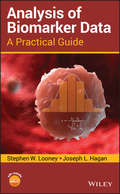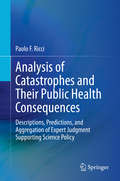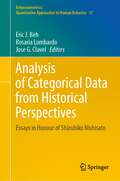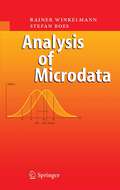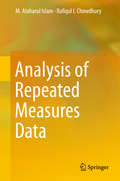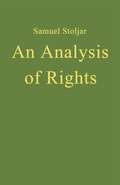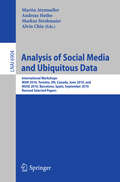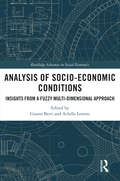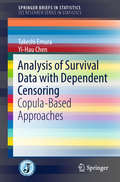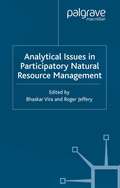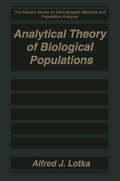- Table View
- List View
Analysis, Design & Evaluation of Man-Machine Systems: Proceedings of the 2nd IFAC/IFIP/IFORS/IEA Conference, Verese, Italy, 10-12 September 1985 (IFAC Symposia Series)
by G. Mancini L. Martensson G. JohannsenProvides a valuable overview of human-machine interaction in technological systems, with particular emphasis on recent advances in theory, experimental and analytical research, and applications related to man-machine systems. Topics covered include: Automation and Operator - task analysis, decision support, task allocation, management decision support, supervisory control, artificial intelligence, training and teaching, expert knowledge; System Concept and Design - software ergonomics, fault diagnosis, safety, design concepts; Man-machine Interface - interface design, graphics and vision, user adaptive interfaces; Systems Operation - process industry, electric power, aircraft, surface transport, prostheses and manual control. Contains 53 papers and three discussion sessions.
Analysis of Biomarker Data: A Practical Guide
by Stephen W. Looney Joseph L. HaganA “how to” guide for applying statistical methods to biomarker data analysis Presenting a solid foundation for the statistical methods that are used to analyze biomarker data, Analysis of Biomarker Data: A Practical Guide features preferred techniques for biomarker validation. The authors provide descriptions of select elementary statistical methods that are traditionally used to analyze biomarker data with a focus on the proper application of each method, including necessary assumptions, software recommendations, and proper interpretation of computer output. In addition, the book discusses frequently encountered challenges in analyzing biomarker data and how to deal with them, methods for the quality assessment of biomarkers, and biomarker study designs. Covering a broad range of statistical methods that have been used to analyze biomarker data in published research studies, Analysis of Biomarker Data: A Practical Guide also features: A greater emphasis on the application of methods as opposed to the underlying statistical and mathematical theory The use of SAS®, R, and other software throughout to illustrate the presented calculations for each example Numerous exercises based on real-world data as well as solutions to the problems to aid in reader comprehension The principles of good research study design and the methods for assessing the quality of a newly proposed biomarker A companion website that includes a software appendix with multiple types of software and complete data sets from the book’s examples Analysis of Biomarker Data: A Practical Guide is an ideal upper-undergraduate and graduate-level textbook for courses in the biological or environmental sciences. An excellent reference for statisticians who routinely analyze and interpret biomarker data, the book is also useful for researchers who wish to perform their own analyses of biomarker data, such as toxicologists, pharmacologists, epidemiologists, environmental and clinical laboratory scientists, and other professionals in the health and environmental sciences.
Analysis of Biomarker Data: A Practical Guide
by Stephen W. Looney Joseph L. HaganA “how to” guide for applying statistical methods to biomarker data analysis Presenting a solid foundation for the statistical methods that are used to analyze biomarker data, Analysis of Biomarker Data: A Practical Guide features preferred techniques for biomarker validation. The authors provide descriptions of select elementary statistical methods that are traditionally used to analyze biomarker data with a focus on the proper application of each method, including necessary assumptions, software recommendations, and proper interpretation of computer output. In addition, the book discusses frequently encountered challenges in analyzing biomarker data and how to deal with them, methods for the quality assessment of biomarkers, and biomarker study designs. Covering a broad range of statistical methods that have been used to analyze biomarker data in published research studies, Analysis of Biomarker Data: A Practical Guide also features: A greater emphasis on the application of methods as opposed to the underlying statistical and mathematical theory The use of SAS®, R, and other software throughout to illustrate the presented calculations for each example Numerous exercises based on real-world data as well as solutions to the problems to aid in reader comprehension The principles of good research study design and the methods for assessing the quality of a newly proposed biomarker A companion website that includes a software appendix with multiple types of software and complete data sets from the book’s examples Analysis of Biomarker Data: A Practical Guide is an ideal upper-undergraduate and graduate-level textbook for courses in the biological or environmental sciences. An excellent reference for statisticians who routinely analyze and interpret biomarker data, the book is also useful for researchers who wish to perform their own analyses of biomarker data, such as toxicologists, pharmacologists, epidemiologists, environmental and clinical laboratory scientists, and other professionals in the health and environmental sciences.
Analysis of Catastrophes and Their Public Health Consequences: Descriptions, Predictions, and Aggregation of Expert Judgment Supporting Science Policy
by Paolo F. RicciPublic health policy prospectively and retrospectively addresses the consequences of events ranging from the commonplace to the catastrophic. Informing policymakers and stakeholders by enhancing their understanding of complex causation to justify remedial or precautionary actions is a critical science-policy task. In this book, the key aspects of catastrophes (regardless of their nature) and routine events are identified through a common framework for their analyses, and the analyses of the consequences associated with the potential occurrence of these events also are discussed. The book is not about disaster planning; instead, it is focused on analysis and causation in the context of informing – rather than formulating – public health policy. The author aggregates and fuses scientific information and knowledge in public health policy-science using alternative but complementary methods. The book first focuses on the analysis of catastrophes and commonplace events; the focus then shifts to causal models of multifactorial diseases, particularly at low doses or dose-rates, associated with these events. Topics explored among the chapters include:Policy and Legal Aspects of Precautionary ChoicesCatastrophes, Disasters, and Calamities: Concepts for Their Assessment Uncertainty: Probabilistic and Statistical AspectsAggregating Judgments to Inform Precautionary Decision-makingThe aim of the book is to show that the analyses of events are fundamentally similar, regardless of whether the concern is a global catastrophe or commonplace. Analysis of Catastrophes and Their Public Health Consequences is a text that should engage students, instructors, and researchers in public health, science policy, and preparedness research, as well as serve as a useful resource for policy analysts, practitioners, and risk managers.
Analysis of Categorical Data from Historical Perspectives: Essays in Honour of Shizuhiko Nishisato (Behaviormetrics: Quantitative Approaches to Human Behavior #17)
by Eric J. Beh Rosaria Lombardo Jose G. ClavelThis collection of essays is in honor of Shizuhiko Nishisato on his 88th birthday and consists of invited contributions only. The book contains essays on the analysis of categorical data, which includes quantification theory, cluster analysis, and other areas of multidimensional data analysis, covering more than half a century of research by the 41 interdisciplinary and international researchers who are contributors. Thus, it offers the wisdom and experience of work past and present and attracts a new generation of researchers to this field. Central to this wisdom and experience is that of Prof. Nishisato, who has spent much of the past 60 years mentoring and providing leadership in the research of quantification theory, especially that of “dual scaling”. The book includes contributions by leading researchers who have worked alongside Prof. Nishisato, published with him, been mentored by him, or whose work has been influenced by the research he has undertaken over his illustrious career. This book inspires researchers young and old as it highlights the significant contributions, past and present, that Prof. Nishisato has made in his field.
Analysis of Delinquency and Aggression (Psychology Library Editions: Aggression)
by Albert Bandura Emilio Ribes-InestaOriginally published in 1976, this volume is organized about two central themes: the experimental analysis of aggression, and the application of learning principles to the prevention and modification of delinquency. The chapters, all new and original at the time, demonstrate how the problems of aggression, which had been interpreted in diverse ways, can be analyzed under controlled laboratory conditions. In addition, the contributors offer an explanation of how behavior modification techniques, derived from this knowledge, can be used for preventive purposes.Because of the social nature of aggression and delinquency, behavior change techniques were principally aimed at modifying environmental influences. The contributions to this volume illustrate how behavioral scientists may aid in the understanding and amelioration of conditions that give rise to violence. Today it can be read and enjoyed in its historical context.
Analysis of Delinquency and Aggression (Psychology Library Editions: Aggression)
by Albert Bandura Emilio Ribes-InestaOriginally published in 1976, this volume is organized about two central themes: the experimental analysis of aggression, and the application of learning principles to the prevention and modification of delinquency. The chapters, all new and original at the time, demonstrate how the problems of aggression, which had been interpreted in diverse ways, can be analyzed under controlled laboratory conditions. In addition, the contributors offer an explanation of how behavior modification techniques, derived from this knowledge, can be used for preventive purposes.Because of the social nature of aggression and delinquency, behavior change techniques were principally aimed at modifying environmental influences. The contributions to this volume illustrate how behavioral scientists may aid in the understanding and amelioration of conditions that give rise to violence. Today it can be read and enjoyed in its historical context.
Analysis of Images, Social Networks and Texts: 8th International Conference, AIST 2019, Kazan, Russia, July 17–19, 2019, Revised Selected Papers (Communications in Computer and Information Science #1086)
by Wil M. P. van der Aalst Vladimir Batagelj Dmitry I. Ignatov Michael Khachay Valentina Kuskova Andrey Kutuzov Sergei O. Kuznetsov Irina A. Lomazova Natalia Loukachevitch Amedeo Napoli Panos M. Pardalos Marcello Pelillo Andrey V. Savchenko Elena TutubalinaThis book constitutes the proceedings of the 8th International Conference on Analysis of Images, Social Networks and Texts, AIST 2019, held in Kazan, Russia, in July 2019.The 24 full papers and 10 short papers were carefully reviewed and selected from 134 submissions (of which 21 papers were rejected without being reviewed). The papers are organized in topical sections on general topics of data analysis; natural language processing; social network analysis; analysis of images and video; optimization problems on graphs and network structures; analysis of dynamic behaviour through event data.
The Analysis of Legal Cases: A Narrative Approach (Law, Language and Communication)
by Flora Di DonatoThis book examines the roles played by narrative and culture in the construction of legal cases and their resolution. It is articulated in two parts. Part I recalls epistemological turns in legal thinking as it moves from theory to practice in order to show how facts are constructed within the legal process. By combining interdisciplinary paradigms and methods, the work analyses the evolution of facts from their expression by the client to their translation within the lawyer-client relationship and the subsequent decision of the judge, focusing on the dynamic activity of narrative construction among the key actors: client, lawyer and judge. Part II expands the scientific framework toward a law-and-culture-oriented perspective, illustrating how legal stories come about in the fabric of the authentic dimensions of everyday life. The book stresses the capacity of laypeople, who in this activity are equated with clients, to shape the law, dealing not just with formal rules, but also with implicit or customary rules, in given contexts. By including the illustration of cases concerning vulnerable clients, it lays the foundations for developing a socio-clinical research programme, whose aims including enabling lay and expert actors to meet for the purposes of improving forms of collective narrations and generating more just legal systems.
The Analysis of Legal Cases: A Narrative Approach (Law, Language and Communication)
by Flora Di DonatoThis book examines the roles played by narrative and culture in the construction of legal cases and their resolution. It is articulated in two parts. Part I recalls epistemological turns in legal thinking as it moves from theory to practice in order to show how facts are constructed within the legal process. By combining interdisciplinary paradigms and methods, the work analyses the evolution of facts from their expression by the client to their translation within the lawyer-client relationship and the subsequent decision of the judge, focusing on the dynamic activity of narrative construction among the key actors: client, lawyer and judge. Part II expands the scientific framework toward a law-and-culture-oriented perspective, illustrating how legal stories come about in the fabric of the authentic dimensions of everyday life. The book stresses the capacity of laypeople, who in this activity are equated with clients, to shape the law, dealing not just with formal rules, but also with implicit or customary rules, in given contexts. By including the illustration of cases concerning vulnerable clients, it lays the foundations for developing a socio-clinical research programme, whose aims including enabling lay and expert actors to meet for the purposes of improving forms of collective narrations and generating more just legal systems.
Analysis of Microdata
by Rainer Winkelmann Stefan BoesThe availability of microdata has increased rapidly over the last decades, and standard statistical and econometric software packages for data analysis include ever more sophisticated modeling options. The goal of this book is to familiarize readers with a wide range of commonly used models, and thereby to enable them to become critical consumers of current empirical research, and to conduct their own empirical analyses. The focus of the book is on regression-type models in the context of large cross-section samples. In microdata applications, dependent variables often are qualitative and discrete, while in other cases, the sample is not randomly drawn from the population of interest and the dependent variable is censored or truncated. Hence, models and methods are required that go beyond the standard linear regression model and ordinary least squares. Maximum li- lihood estimation of conditional probability models and marginal probability e?ects are introduced here as the unifying principle for modeling, estimating and interpreting microdata relationships. We consider the limitation to m- imum likelihood sensible, from a pedagogical point of view if the book is to be used in a semester-long advanced undergraduate or graduate course, and from a practical point of view because maximum likelihood estimation is used in the overwhelming majority of current microdata research. In order to introduce and explain the models and methods, we refer to a number of illustrative applications. The main examples include the deter- nants of individual fertility, the intergenerational transmission of secondary schoolchoices,andthewageelasticityoffemalelaborsupply.
Analysis of Repeated Measures Data
by M. Ataharul Islam Rafiqul I ChowdhuryThis book presents a broad range of statistical techniques to address emerging needs in the field of repeated measures. It also provides a comprehensive overview of extensions of generalized linear models for the bivariate exponential family of distributions, which represent a new development in analysing repeated measures data. The demand for statistical models for correlated outcomes has grown rapidly recently, mainly due to presence of two types of underlying associations: associations between outcomes, and associations between explanatory variables and outcomes. The book systematically addresses key problems arising in the modelling of repeated measures data, bearing in mind those factors that play a major role in estimating the underlying relationships between covariates and outcome variables for correlated outcome data. In addition, it presents new approaches to addressing current challenges in the field of repeated measures and models based on conditional and joint probabilities. Markov models of first and higher orders are used for conditional models in addition to conditional probabilities as a function of covariates. Similarly, joint models are developed using both marginal-conditional probabilities as well as joint probabilities as a function of covariates. In addition to generalized linear models for bivariate outcomes, it highlights extended semi-parametric models for continuous failure time data and their applications in order to include models for a broader range of outcome variables that researchers encounter in various fields. The book further discusses the problem of analysing repeated measures data for failure time in the competing risk framework, which is now taking on an increasingly important role in the field of survival analysis, reliability and actuarial science. Details on how to perform the analyses are included in each chapter and supplemented with newly developed R packages and functions along with SAS codes and macro/IML. It is a valuable resource for researchers, graduate students and other users of statistical techniques for analysing repeated measures data.
Analysis of Science, Technology, and Innovation in Emerging Economies
by Clara Inés Pardo Martínez Alexander Cotte Poveda Sylvia Patricia Fletscher MorenoThis book outlines a number of different perspectives on the relationship between science, technology, and innovation in emerging economies. In it, the authors explore the aforementioned relationship as a pillar of economic development, driving growth in emerging economies. Employing a collaborative and interdisciplinary approach, the authors work to determine the main related factors and outcomes of the relationship between science, technology, and innovation, ultimately seeking to guide public policies to enhance the welfare of the population of an emerging economy.
Analysis of Social Media and Ubiquitous Data: International Workshops MSM 2010, Toronto, Canada, June 13, 2010, and MUSE 2010, Barcelona, Spain, September 20, 2010, Revised Selected Papers (Lecture Notes in Computer Science #6904)
by Martin Atzmueller Andreas Hotho Markus Strohmaier Alvin ChinThis book constitutes the joint thoroughly refereed post-proceedings of The Modeling Social Media Workshop, MSM 2010 held in Toronto, Canada in June 2010 and the International Workshop on Mining Ubiquitous and Social Environments, MUSE 2010, held in Barcelona, Spain in September 2010.The eight revised full papers included were carefully reviewed and selected after two rounds of reviewing and revision. The papers address various aspects of the analysis and engineering of socio-computational systems in which social, ubiquitous and computational processes are interdependent and tightly interwoven
Analysis of Socio-Economic Conditions: Insights from a Fuzzy Multi-dimensional Approach (Routledge Advances in Social Economics)
by Gianni Betti Achille LemmiShowcasing fuzzy set theory, this book highlights the enormous potential of fuzzy logic in helping to analyse the complexity of a wide range of socio-economic patterns and behaviour. The contributions to this volume explore the most up-to-date fuzzy-set methods for the measurement of socio-economic phenomena in a multidimensional and/or dynamic perspective. Thus far, fuzzy-set theory has primarily been utilised in the social sciences in the field of poverty measurement. These chapters examine the latest work in this area, while also exploring further applications including social exclusion, the labour market, educational mismatch, sustainability, quality of life and violence against women. The authors demonstrate that real-world situations are often characterised by imprecision, uncertainty and vagueness, which cannot be properly described by the classical set theory which uses a simple true–false binary logic. By contrast, fuzzy-set theory has been shown to be a powerful tool for describing the multidimensionality and complexity of social phenomena. This book will be of significant interest to economists, statisticians and sociologists utilising quantitative methods to explore socio-economic phenomena.
Analysis of Socio-Economic Conditions: Insights from a Fuzzy Multi-dimensional Approach (Routledge Advances in Social Economics)
by Gianni Betti and Achille LemmiShowcasing fuzzy set theory, this book highlights the enormous potential of fuzzy logic in helping to analyse the complexity of a wide range of socio-economic patterns and behaviour. The contributions to this volume explore the most up-to-date fuzzy-set methods for the measurement of socio-economic phenomena in a multidimensional and/or dynamic perspective. Thus far, fuzzy-set theory has primarily been utilised in the social sciences in the field of poverty measurement. These chapters examine the latest work in this area, while also exploring further applications including social exclusion, the labour market, educational mismatch, sustainability, quality of life and violence against women. The authors demonstrate that real-world situations are often characterised by imprecision, uncertainty and vagueness, which cannot be properly described by the classical set theory which uses a simple true–false binary logic. By contrast, fuzzy-set theory has been shown to be a powerful tool for describing the multidimensionality and complexity of social phenomena. This book will be of significant interest to economists, statisticians and sociologists utilising quantitative methods to explore socio-economic phenomena.
Analysis of Survival Data with Dependent Censoring: Copula-Based Approaches (SpringerBriefs in Statistics)
by Takeshi Emura Yi-Hau ChenThis book introduces readers to copula-based statistical methods for analyzing survival data involving dependent censoring. Primarily focusing on likelihood-based methods performed under copula models, it is the first book solely devoted to the problem of dependent censoring. The book demonstrates the advantages of the copula-based methods in the context of medical research, especially with regard to cancer patients’ survival data. Needless to say, the statistical methods presented here can also be applied to many other branches of science, especially in reliability, where survival analysis plays an important role. The book can be used as a textbook for graduate coursework or a short course aimed at (bio-) statisticians. To deepen readers’ understanding of copula-based approaches, the book provides an accessible introduction to basic survival analysis and explains the mathematical foundations of copula-based survival models.
Analysis of the Development of Beijing, 2019
by Beijing Academy of Social SciencesThis book provides an overview of the rapid development Beijing has seen in a wide range of areas in 2018, both in itself and as an integral part of a larger region, as China’s economic development continues to improve in overall quality and regional coordination. General reports on progress Beijing made and problems it faced in 2018 in improving its economy, public services, and municipal and community governance, urban planning, and funding for innovations are followed by case studies that look at best practices and how they can be applied towards promoting coordinated development of the Beijing-Tianjin-Hebei region. The strategy features prominently in the outlook contributors present for the greater metropolitan area of Beijing for 2019.This book is a valuable source of reference for anyone trying to gain a better understanding the what, how, and why in relation to one of the world’s fastest growing mega-cities.
Analytic Activism: Digital Listening and the New Political Strategy (Oxford Studies in Digital Politics)
by David KarpfAmong the ways that digital media has transformed political activism, the most remarkable is not that new media allows disorganized masses to speak, but that it enables organized activist groups to listen. Beneath the waves of e-petitions, "likes," and hashtags lies a sea of data - a newly quantified form of supporter sentiment - and advocacy organizations can now utilize new tools to measure this data to make decisions and shape campaigns. In this book, David Karpf discusses the power and potential of this new "analytic activism," exploring the organizational and media logics that determine how digital inputs shape the choices that political campaigners make. He provides the first careful analysis of how organizations like Change.org and Upworthy.com influence the types of political narratives that dominate our Facebook newsfeeds and Twitter timelines, and how MoveOn.org and its "netroots" peers use analytics to listen more effectively to their members and supporters. As well, he identifies the boundaries that define the scope of this new style of organized citizen engagement. But also raising a note of caution, Karpf identifies the dangers and limitations in putting too much faith in these new forms of organized listening.
ANALYTIC ACTIVISM OSDP C: Digital Listening and the New Political Strategy (Oxford Studies in Digital Politics)
by David KarpfAmong the ways that digital media has transformed political activism, the most remarkable is not that new media allows disorganized masses to speak, but that it enables organized activist groups to listen. Beneath the waves of e-petitions, "likes," and hashtags lies a sea of data - a newly quantified form of supporter sentiment - and advocacy organizations can now utilize new tools to measure this data to make decisions and shape campaigns. In this book, David Karpf discusses the power and potential of this new "analytic activism," exploring the organizational and media logics that determine how digital inputs shape the choices that political campaigners make. He provides the first careful analysis of how organizations like Change.org and Upworthy.com influence the types of political narratives that dominate our Facebook newsfeeds and Twitter timelines, and how MoveOn.org and its "netroots" peers use analytics to listen more effectively to their members and supporters. As well, he identifies the boundaries that define the scope of this new style of organized citizen engagement. But also raising a note of caution, Karpf identifies the dangers and limitations in putting too much faith in these new forms of organized listening.
Analytical Issues in Participatory Natural Resources (Global Issues)
by B. Vira R. JefferyAttempts to manage natural resources through collaboration rather than competition, by agreements rather than conflict, have become the touchstone for many who see these efforts as the harbinger of global sustainable development. The received wisdom suggests that participatory natural resource management projects work because traditional knowledge of the resources and existing social structures can be utilised to develop more effective strategies for resource use. Participation is a flexible and adaptable concept, which can reflect local circumstances and priorities. The contributors to this volume advise caution as well as optimism for projects conducted in this way. By drawing on the experience of NGOs, national governments and donor sectors as well as academic researchers this volume analyses the theory and practice of participatory natural resource management and demonstrates the value of constructive dialogue between all those involved.
Analytical Sociology: Actions and Networks (Wiley Series in Computational and Quantitative Social Science)
by Gianluca ManzoDemonstrates the power of the theoretical framework of analytical sociology in explaining a large array of social phenomena Analytical Sociology: Actions and Networks presents the most advanced theoretical discussion of analytical sociology, along with a unique set of examples on mechanism- based sociology. Leading scholars apply the theoretical principles of analytical sociology to understand how puzzling social and historical phenomena including crime, lynching, witch-hunts, tax behaviours, Web-based social movement and communication, restaurant reputation, job search and careers, social network homophily and instability, cooperation and trust are brought about by complex, multi-layered social mechanisms. The analyses presented in this book rely on a wide range of methods which include qualitative observations, advanced statistical techniques, complex network tools, refined simulation methods and creative experimental protocols. This book ultimately demonstrates that sociology, like any other science, is at its best when it dissects the mechanisms at work by means of rigorous model building and testing. Analytical Sociology: • Provides the most complete and up-to-date theoretical treatment of analytical sociology. • Looks at a wide range of complex social phenomena within a single and unitary theoretical framework. • Explores a variety of advanced methods to build and test theoretical models. • Examines how both computational modelling and experiments can be used to study the complex relation between norms, networks and social actions. • Brings together research from leading global experts in the field in order to present a unique set of examples on mechanism-based sociology. Advanced graduate students and researchers working in sociology, methodology of social sciences, statistics, social networks analysis and computer simulation will benefit from this book.
Analytical Sociology: Actions and Networks (Wiley Series in Computational and Quantitative Social Science)
by Gianluca ManzoDemonstrates the power of the theoretical framework of analytical sociology in explaining a large array of social phenomena Analytical Sociology: Actions and Networks presents the most advanced theoretical discussion of analytical sociology, along with a unique set of examples on mechanism- based sociology. Leading scholars apply the theoretical principles of analytical sociology to understand how puzzling social and historical phenomena including crime, lynching, witch-hunts, tax behaviours, Web-based social movement and communication, restaurant reputation, job search and careers, social network homophily and instability, cooperation and trust are brought about by complex, multi-layered social mechanisms. The analyses presented in this book rely on a wide range of methods which include qualitative observations, advanced statistical techniques, complex network tools, refined simulation methods and creative experimental protocols. This book ultimately demonstrates that sociology, like any other science, is at its best when it dissects the mechanisms at work by means of rigorous model building and testing. Analytical Sociology: • Provides the most complete and up-to-date theoretical treatment of analytical sociology. • Looks at a wide range of complex social phenomena within a single and unitary theoretical framework. • Explores a variety of advanced methods to build and test theoretical models. • Examines how both computational modelling and experiments can be used to study the complex relation between norms, networks and social actions. • Brings together research from leading global experts in the field in order to present a unique set of examples on mechanism-based sociology. Advanced graduate students and researchers working in sociology, methodology of social sciences, statistics, social networks analysis and computer simulation will benefit from this book.
Analytical Theory of Biological Populations (The Springer Series on Demographic Methods and Population Analysis)
by Alfred J. LotkaIn the 50 years that have passed since Alfred Latka's death in 1949 his position as the father of mathematical demography has been secure. With his first demographic papers in 1907 and 1911 (the latter co authored with F. R. Sharpe) he laid the foundations for stable population theory, and over the next decades both largely completed it and found convenient mathematical approximations that gave it practical applica tions. Since his time, the field has moved in several directions he did not foresee, but in the main it is still his. Despite Latka's stature, however, the reader still needs to hunt through the old journals to locate his principal works. As yet no exten sive collections of his papers are in print, and for his part he never as sembled his contributions into a single volume in English. He did so in French, in the two part Theorie Analytique des Associations Biologiques (1934, 1939). Drawing on his Elements of Physical Biology (1925) and most of his mathematical papers, Latka offered French readers insights into his biological thought and a concise and mathematically accessible summary of what he called recent contributions in demographic analy sis. We would be accurate in also calling it Latka's contributions in demographic analysis.

